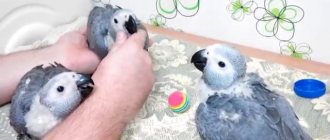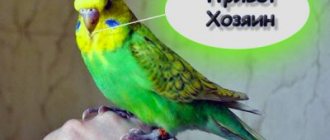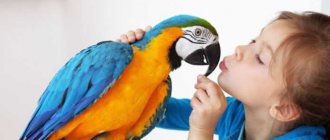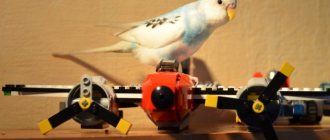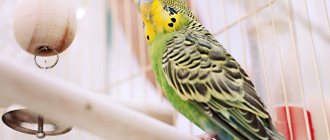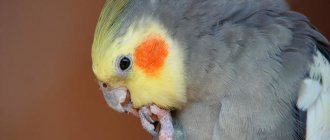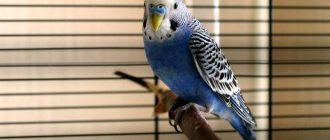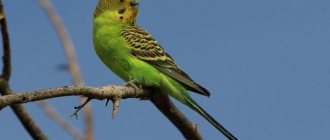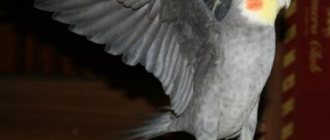Budgerigar: can he learn to talk in one day?
The budgerigar is a bird that brings joy with its chirping and playful disposition. You definitely won’t get bored with such a pet! Another advantage of the parrot is its ability to talk. Therefore, owners who have purchased a bird certainly want to teach their pet the wisdom of human speech.
In fact, pushing a parrot to communicate with a person is not so easy. In order for a pet to repeat at least one word, months of training are required. Therefore, do not believe posts on the Internet that promise that the bird will speak in one day or even a week. This is simply impossible.
Photo: pixabay.com: UGC
On average, training a parrot will take about 3 months. The deadline can move in one direction or the other depending on the pet's ability.
Important note: if you want to train a parrot, do not do it immediately after purchasing it. Wait a week or two for your pet to get comfortable and get used to you. First, gain the bird’s trust, and only then stimulate him to new knowledge.
A quick method for teaching a parrot to talk
For training, choose either young individuals or adult males no older than 4 years. The most difficult words to learn are the first words. A “talking” person will remember words faster. In this regard, in the presence of a pet it is necessary to monitor your speech. To teach a bird to “speak” as quickly as possible, use the following recommendations:
- Choose the right class time. It is recommended to set aside time for lessons in the morning before feeding. However, according to trainers, the quality of training is not affected by what time classes are held. The main thing is that the lessons are regular and the bird stays awake. In addition, during the day you should address your pet several times, as if you were a small child, pronouncing the right words.
- Create a pleasant atmosphere. During classes, it is necessary to maintain a friendly attitude. The “student” should feel comfortable and safe. You cannot raise your voice, wave your arms, or threaten. Classes should be fun. In this regard, it is recommended to sit the bird on your hand during the lesson, but the pet must do this himself. Picking it up and forcibly holding it on your hand is strictly prohibited. The room should be warm and light.
- What words to start with? The training program should include words containing the vowels “a” or “o”; among the consonants, “k”, “p”, “r”, “t” are recommended. Examples of such words are: Roma, dad, Cora, Tom and others. Birds remember words with hissing words well: eat, Kesha, chao, Gosha. It is recommended to take the pet's name as the first word to learn if it contains no more than two syllables.
- Watch your speech. Once the learning process has started, you need to pay attention to your vocabulary. Parrots are attentive students and will imitate even those words that you accidentally used. Avoid using abusive language or profanity in the presence of your pet. Otherwise, the “student” will learn the wrong lesson.
- Learning poems and songs using a tape recorder. As additional training tools, it is recommended to use technical equipment - tape recorder, voice recorder. They use TS to memorize voluminous information. The poem or song is recorded on a tape recorder and audio material is included as needed. In this case, you should be present next to your pet. The use of TS provides the opportunity to repeat educational material many times.
- Praise your pet often during training. The key to the success of classes is the positive attitude of the student. For this reason, during lessons it is necessary to constantly encourage and praise the parrot, regardless of its success. The slightest rudeness or careless movement can cause fear and anxiety in the little “student”. Regaining your pet's trust after this will not be easy.
Budgerigars: which ones are predisposed to learning
Budgerigars are capable birds, and they can all talk. However, it is worth knowing that some individuals are very difficult to train. Others, on the contrary, will be able to repeat words earlier than their counterparts.
So, if you want to hear your budgie talk, get a male. Boys find learning easier than girls. Females are also able to talk, but the process can take a long time. The advantage is that they pronounce words more clearly.
Photo: pixabay.com: UGC
For a parrot to speak, it is optimal if it lives alone. Pets that are in a pair are busy with each other and therefore rarely communicate in human language. But if you add a female to a male who has already mastered speech, he can teach her to speak too. Although such cases are also rare.
Branch food for parrots
Feeding parrots must be correct. Their diet should contain not only grain mixtures, vegetables and fruits, but also twig food. Most owners don’t even know that twigs are necessary for proper nutrition. The twigs contain fiber and microelements, and they also help care for the beak.
What branches can you give:
- birch;
- hazel;
- elder;
- aspen;
- maple;
- Linden;
- Rowan;
- Apple tree.
They need to be collected away from roads and first doused with boiling water. Twigs can be given all year round. In winter, they should be placed in water to allow the buds to swell.
Budgerigar: at what age is it easier to teach to speak?
If you are wondering how to teach a parrot to speak, then you are probably thinking not only about the bird’s gender, but also about its age. And it is right. Of course, a pet's ability to speak depends on its talent. But age is also important: it is easier to teach a young male to communicate than an adult.
When should you start speech lessons? Feel free to work with the bird if a little more than a month has passed since its birth. You can start training in the near future. If the bird is more than five months old, it will be difficult for her to master speech.
Photo: pixabay.com: UGC
Please note that adult females are practically resistant to verbal training. It is possible to work with older males, but it will not be easy.
Of course, it is difficult to determine the age of a parrot by eye. We advise you to pay attention to the head: the bird’s first molt begins around three months. Therefore, if a pet’s feathers are wavy in color right up to its beak, it is still a chick. The babies also have a paler color and a short tail, black eyes, and smooth paws.
Juices and water
Parrots must get water. Its amount depends on how much water the pet gets from fruits and vegetables and what the air temperature is in the room. You need to change the water daily, even if it seems to you that your pet hasn’t drunk it. In summer, you need to change it 2 times a day.
It is better not to give boiled, carbonated and tap water. Fill the drinker with filtered or bottled water. It is possible to add lemon juice, rosehip or chamomile decoction to the water.
Juices are considered no less beneficial for parrots. You can make it in a juicer or buy ready-made baby juices, the main thing is that they do not contain sugar. It is possible to dilute them with water. Keep an eye on the freshness of the juice, they can spoil very quickly, especially in summer.
How to teach a budgie to talk: basic steps
So, the pet is already at your home and meets all the requirements. He has already gotten used to it, is not afraid and has chosen you as his master (this is very important for training). It's time to discuss how to teach a budgie to speak. Read the information and get started:
- Choose the word you want to teach your parrot. It's best if it's the pet's name. By the way, when choosing a nickname, make sure that it is light.
- Repeat the word while looking at the parrot. Talk to the bird closely so that it understands that the sounds are addressed to it. It is important that your parrot hears you. The bird usually shows interest by tilting its head. After several trainings, she can open her beak, albeit silently for now.
- Speak the word clearly and distinctly. When you exercise for a long time, your pet will try to respond to you. At first it will be like hissing, some sounds, and only then you will hear the word.
- Exercise your parrot daily. Training time should be between 5–20 minutes. Postpone the lesson if your pet is not in the mood.
- To reward your bird, praise it and give it food that your bird likes.
Photo: pixabay.com: Depositphotos
Please note that a parrot cannot think the same way as a human. He only imitates speech, imitating you. However, if you tie the word to the situation, the parrot will reproduce it at the right moment. For example, teach your pet to say “hello” when you come home from work. You can also teach your parrot more fun words, such as “Ciao.”
Interesting facts about parrots and their diet
Do you know that in nature there are 300 species and 80 genera of parrots? And each of them needs its own approach.
Wavy beauties
Budgerigars are the most common ornamental birds in the world.
- They can imitate sounds, human speech and the voices of other animals.
- The world record for vocabulary among a species belongs to the budgerigar Puck, who knew 1,728 words. On average, such parrots master 100-150 words.
- Among these parrots there are right-handers and left-handers.
- They love to sleep and spend 10-12 hours a day doing this activity.
- They can turn their head 180 degrees.
Unusual bird feeders or how good things come back with joy
Add to cart
Quick view
Compare
Close
FIORY food for budgies ORO MIX Cocory
400,00 ₽
Hit
Add to cart
Quick view
Compare
Close
FIORY food for budgerigars Pappagallini
Rating 5 out of 5
400,00 ₽
Do you have a parrot like this? What do you feed him? Try Fiory Pappagallini Budgerigar Mix. It contains safflower seeds, which are high in fiber, oils and protein, which improve pigmentation. In addition, safflower contains potassium, calcium, magnesium, B vitamins, and linoleic acid. The mixture granules include a complex of nutraceuticals, vitamins, minerals, proteins, carbohydrates and amino acids. The lifespan of captive budgies can vary significantly: from 5 to 15 years. And this largely depends on the correct nutrition.
Restless lovebirds
Medium-sized parrots are no less common for keeping at home, among which lovebirds occupy a special place.
- These parrots are known for their loyalty, which is why they got their name.
- You can never be sure whether a lovebird will speak or not.
- They reproduce better than other species in captivity.
- They wither without flying, so they must be released from the cage.
- They cannot tolerate rare odors.
- They are very inquisitive and like magpies greedy for shiny things.
- Some of the most ancient bird species appeared on Earth about 50 million years ago.
Add to cart
Quick view
Compare
Close
FIORY food for medium parrots Classic
300,00 ₽
Add to cart
Quick view
Compare
Close
FIORY food for medium parrots Parrocchetti African
1 600,00 ₽
Parrots' metabolism runs at breakneck speed. Everything eaten is digested and absorbed within a few hours. This occurs due to the characteristics of gastric juice and enzymes that break down food. A complete food for lovebirds and other medium-sized parrots should include proteins, carbohydrates, fats, and many vitamins and minerals.
Chicken coop - like a work of design art
Fiory Parrocchetti Parrot Mix contains 13 ingredients including:
- hemp seeds, which contain highly digestible proteins,
- carob fruits, which have high nutritional and taste value and strengthen the immune system;
- sweet dried quiche, rich in dietary fiber, vitamins, protein and microelements;
- safflower, sunflower seeds, corn and other tasty and healthy ingredients.
The mixture is enriched with Omega-3 fatty acids, selenium and chelated minerals.
The smartest gray parrots
Grays are considered one of the most intelligent birds in the world. And despite the fact that their coloring is inferior to their bright relatives, they are a very common species for home keeping.
- The Gray's intelligence level is comparable to the development of a three to four year old child.
- These parrots can not only learn words, but also form meaningful sentences.
- Grays are generally not afraid of water. On the contrary, they look for every opportunity to swim.
- Parrots need communication; due to its lack, the Gray's character deteriorates and even mental disorders are possible.
- At home, gray parrots can live 40-50 years.
Gift or test: a gray parrot settled in our house
Add to cart
Quick view
Compare
Close
FIORY food for large parrots Classic
400,00 ₽
Add to cart
Quick view
Compare
Close
FIORY food for large parrots Pappagalli
Rating 5 out of 5
450,00 ₽
How long Grays live at home depends to a large extent on their diet. Large parrots require special care. Fiory Parrots formula, intended for feeding Grays and other large species, contains 11 different ingredients, including:
- pumpkin seeds with a delicious taste and tonic effect, containing vitamins A, B, C, calcium, phosphorus and iron;
- whole peanuts containing vitamin D, B vitamins, amino acids and minerals;
- corn, oats, wheat, and other nutritious and health-promoting ingredients for birds.
Feed your Gray correctly, and he will definitely respond to you with love and come to chat.
You can find out everything about products and promotions on our telegram channel Magazine-shop “My Good”
If you find an error, please select a piece of text and press Ctrl+Enter.
Use of materials on other resources is possible only with the written consent of the editors and co-authors of the articles
Natalya Kocheganova
Author, employee of “My good one”. Writes, sings, dances, plays, sews, knits, travels. I am familiar firsthand with the beneficial work of gardening. Loves life in all its shades, sounds and textures. Loves creativity and creative people, regardless of the field of implementation.
How to teach a budgie to speak: important nuances
Trying to communicate with your parrot every day, but it doesn't work? It is quite possible that the problem is not with the bird, but with your behavior. Be sure to consider a few nuances that will help you succeed.
For example:
- Make sure you choose the right pet. It is quite possible that the seller handed you an already adult bird. Not surprisingly, the learning process was slow.
- Only one person should train the bird.
- Choose a quiet room to study. Turn off the TV, computer and radio. The parrot should focus on your speech and not be distracted by extraneous sounds.
- Do not handle your parrot if you see that he is already tired. For some birds, 5 minutes will seem like an eternity. In this case, postpone or reschedule the lesson.
- During the lesson, remove the pet's mirror and toys from the cage. The point is that these objects will distract the parrot. But after the lesson, return everything to its place. After a while you will be able to see your pet rehearsing words in front of his own reflection.
- It’s good if a girl or child works with the parrot. Birds perceive high pitched voices better.
Photo: pixabay.com: UGC
Parrots are capable and inquisitive. However, if your pet doesn’t succeed, then don’t despair: all skills will come with time.
What do budgies tweet about?
If you decide to learn how to figure out what your bird is all about or why it is chirping displeasedly, then for such a seemingly complex task you will only need patience and attention.
Sounds of budgies:
- Sharp, short, frequently repeated sounds mean that your bird is dissatisfied with something, and perhaps is swearing or indignant. The reason could be anything - an encroachment on her personal territory, dissatisfaction with your movements, and so on. Such indignation, like that of people, will soon pass. Having heard such sounds, experts advise checking the availability of food and its usual living conditions.
- A sound similar to “quacking” is a kind of alarm signal, panic. Thus, parrots protest against something that does not suit them. This may be a reaction to trying to pet, pick up, or force-feed the bird. If your pet is very anxious, along with the sounds, it will also flap its wings and move quickly along the perch.
- Intermittent “quacking” indicates a desire to attract the attention of its relatives. And if there are none nearby, it means the owner.
- Silence and flapping of wings on the sides are a signal of the extreme stage of indignation. Roughly speaking, your bird no longer has “words”, so it silently complains, attracting your attention.
- Silence, accompanied by the parrot's half-closed eyes, communicates the intention to rest and sleep. In such a situation, you simply need to leave the pet alone.
- Measured cooing is the calm tone of a parrot. He's in great spirits. Your budgie is happy with everything. Cooing accompanied by chirping should be a signal to the owner that your bird wants to get a tasty treat and attract attention.
- Singing. For parrots living in the wild, singing is the most common activity during courtship. While in captivity, the bird does this for its own pleasure. Moreover, sometimes parrots perfectly copy the singing of other birds.
It is a widely known fact that parrots are excellent at copying sounds from their environment. And this will not necessarily be the speech of a person or birds outside the window; a parrot may well repeat the sounds of typing on a keyboard, ringing the doorbell and much more. Therefore, if the owner has a desire to teach his pet human speech, then the only obstacle can be the person’s laziness or lack of patience.
A parrot is capable of repeating not only words, but even phrases that sound with the same intonation with which a person pronounced them. Therefore, with the right approach and a reserve of limitless patience, you can start learning . After a while, your beautiful, bright pet will begin to repeat not only words, but also phrases and even entire sentences.
Take a close look at your bird, and you will notice that it has its own character, habits and even habits. Communicate with him, devote at least a couple of minutes of attention to him every day and you will definitely see something interesting.
Recommended age to start training
Budgerigars become adults by 9–10 months. It has been noticed that young birds cope much more successfully with sound imitation lessons than adults.
Experts believe that the optimal time when a parrot begins to accept training is from 1 to 4 months. While the teenage bird is in the nest, they do not work with it. If a person begins to regularly communicate with a budgie that has been separated from its parents, it will start talking within 3–3.5 months.
Interesting! Even the most experienced trainer cannot quickly teach five-month-old (and older) wavy dogs to talk. This will require several months and a lot of patience from the owner. There will be a result, but only if the parrots have a balanced diet and good care for them.
The most beautiful
All parrots are distinguished by their uniqueness and brightness of colors. Many consider them to be the most beautiful birds in the world. But some of the most beautiful parrots, in our opinion, stand out especially.
| Name | Description | Photo |
| Eclectus, Noble Parrot | Eclectus live off the coast of Australia and New Guinea. A characteristic feature of these beautiful birds is the different colors of males and females. Males of Eclectus are bright green, and females are rich red. | |
| Variegated rosella | The variegated rosella fully lives up to its name; its plumage is varied, elaborate and unique. This motley bird has the ability to learn, and therefore it can easily be taught several phrases. | |
| Macaw | The macaw is the largest representative of the parrots. Natural habitat - South America. The colors of the Macaw are varied, the hyacinth is considered the rarest in the world, but each of them is certainly good in its own way. | |
| Inca cockatoo | This beautiful species with an unusual crest is on the verge of extinction. And all because his favorite eucalyptus thickets are being massively destroyed. Catching the Inka Cockatoo is prohibited and seeing one kept at home is very rare. | |
| Golden aratinga | This medium-sized parrot is famous for its bright yellow color. Inhabits the mountain forests of Brazil and has a sociable, funny disposition. No less beautiful is the Sunny Aratinga, which is slightly smaller in size. | |
| Multicolored lorikeet | Very bright and unusual look. Inhabits tropical forests of Australia, New Guinea, Tasmania. The color, which contains admixtures of almost all colors, is very popular among breeders all over the world. | |
| fan parrot | A distinctive feature of the Fan Parrot is the abundant feather decoration on its head. Moreover, each feather of the bird is effectively framed. The fan parrot is good for keeping at home; it appreciates human company and quickly becomes attached to its owner. |
What not to feed parrots
It is not recommended to allow birds to grab human food from the table. A touching feast, when the pet and the owner eat from the same plate, can lead to unpleasant consequences and even to the death of the bird. It is strictly forbidden to use the following products as food for parrots:
- potato;
- mushrooms;
- spices;
- onion;
- avocado;
- sorrel.
Salty, fatty, smoked foods are strictly prohibited, you can’t even try them. And you should not feed the parrot from your mouth - this is a direct way of transmitting microbes and fungi.

